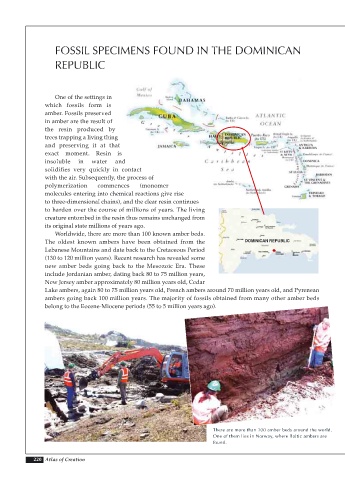Page 222 - Atlas of Creation Volume 1
P. 222
FOSSIL SPECIMENS FOUND IN THE DOMINICAN
REPUBLIC
One of the settings in
which fossils form is
amber. Fossils preserved
in amber are the result of
the resin produced by
trees trapping a living thing
and preserving it at that
exact moment. Resin is
insoluble in water and
solidifies very quickly in contact
with the air. Subsequently, the process of
polymerization commences (monomer
molecules entering into chemical reactions give rise
to three-dimensional chains), and the clear resin continues
to harden over the course of millions of years. The living
creature entombed in the resin thus remains unchanged from
its original state millions of years ago.
Worldwide, there are more than 100 known amber beds.
The oldest known ambers have been obtained from the DOMINICAN REPUBLIC
Lebanese Mountains and date back to the Cretaceous Period
(130 to 120 million years). Recent research has revealed some
new amber beds going back to the Mesozoic Era. These
include Jordanian amber, dating back 80 to 75 million years,
New Jersey amber approximately 80 million years old, Cedar
Lake ambers, again 80 to 75 million years old, French ambers around 70 million years old, and Pyrenean
ambers going back 100 million years. The majority of fossils obtained from many other amber beds
belong to the Eocene-Miocene periods (55 to 5 million years ago).
There are more than 100 amber beds around the world.
One of them lies in Norway, where Baltic ambers are
found.
220 Atlas of Creation

